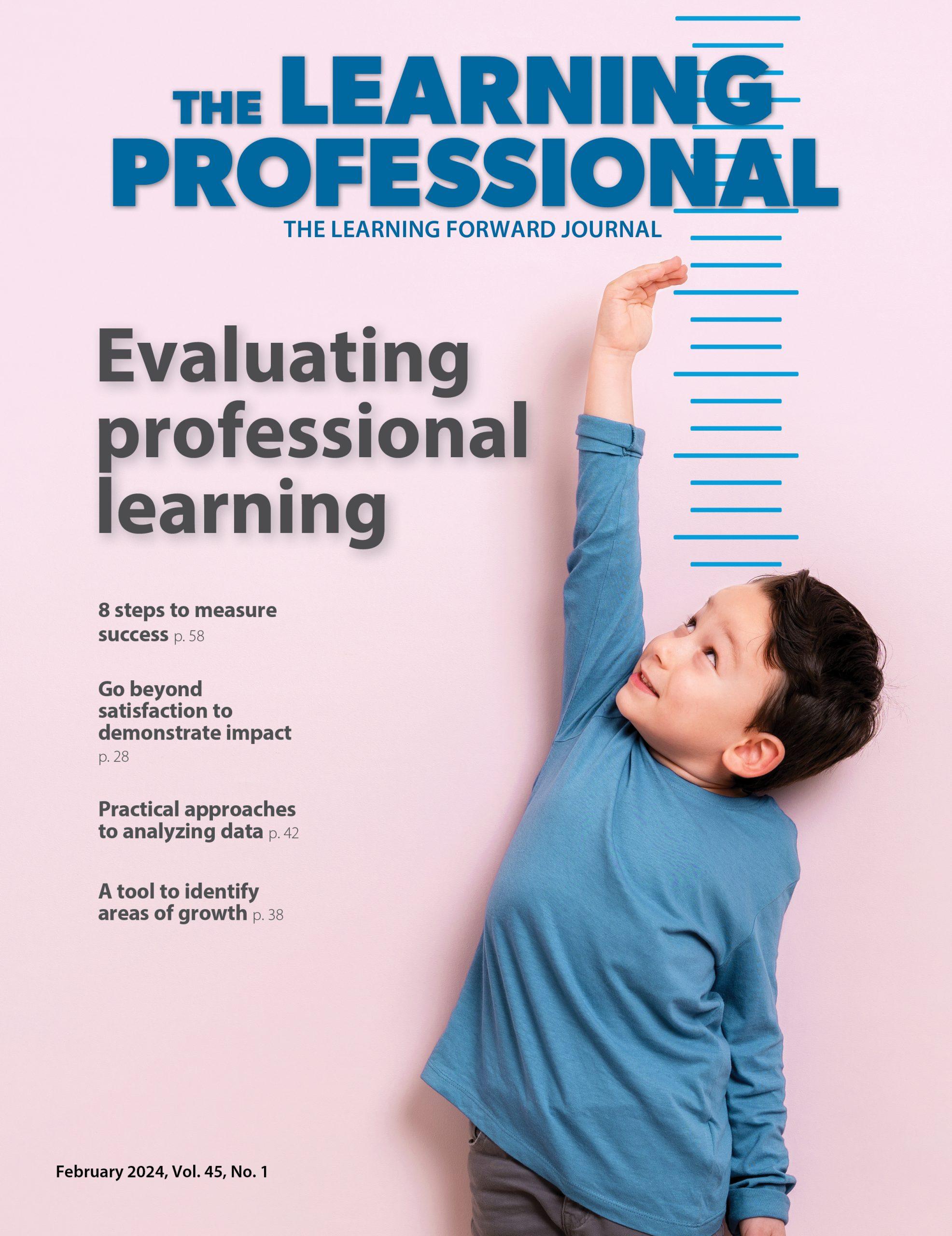Virtual Reality Check
Teachers use bug-in-ear coaching to practice feedback techniques with student avatars.
By Learning Forward
February 2013
Read the remaining content with membership access. Join or log in below to continue.
Sed ut perspiciatis unde omnis iste natus error sit voluptatem accusantium doloremque laudantium, totam rem aperiam, eaque ipsa quae ab illo inventore veritatis et quasi architecto beatae vitae dicta sunt explicabo. Nemo enim ipsam voluptatem quia voluptas sit aspernatur aut odit aut fugit, sed quia consequuntur magni dolores eos qui ratione voluptatem sequi nesciunt. Neque porro quisquam est, qui dolorem ipsum quia dolor sit amet, consectetur, adipisci velit, sed quia non numquam eius modi tempora incidunt ut labore et dolore magnam aliquam quaerat voluptatem.
| Percentage of disruptive behaviors addressed using positive feedback | ||||
| session 1 | session 2 | session 3 | session 4 | |
| Participant 1 | 75% | 70% | 90% | 100% |
| Participant 2 | 70% | 90% | 80% | 100% |
| Participant 3 | 60% | 75% | 80% | 75% |
| Participant 4 | 55% | 55% | 80% | 80% |
| Shaded boxes indicate the sessions in which participants were coached remotely. |
| Ways to get and give feedback | |||
| Immediate: Immediate feedback occurs within seconds or moments of the event. Recipients don’t need to wait to discover if their efforts are moving them closer to their goal.
Delayed: Delayed feedback occurs some time after the event or action. |
Written: Written feedback can be a performance review, a note in response to an observation, or just a few phrases describing what occurred. It offers a permanent record of the feedback that can be referenced at a later time.
Verbal: Verbal feedback is spoken and can be delivered immediately, face-to-face or remotely. Nonverbal: Nonverbal feedback is often noticed in body language, such as students off-task during class or someone sleeping during a speech. Even a person who fidgets or looks away is giving feedback to the speaker that she is not completely comfortable. |
Positive: Positive feedback can be described as anything that encourages a person toward the desired goal.
Negative: Negative feedback can feel like criticism or redirection. |
Critical: Webster defines critical feedback as “the act of criticizing unfavorably.” However, critical feedback can be constructive feedback when delivered properly and without judging.
Affirming: Feedback that affirms is direct, specific, and nonattributive (Kegan & Lahey, 2001). This type of feedback infuses ongoing regard from the speaker. |
Let’s Get Reel: Video Brings Practices to Life
While having a coach at a teacher’s side — or in his ear — is a powerful, real-time support system, opportunities to watch and discuss real-life teaching are flourishing, thanks to the use of video cameras. Here is a sampling of tools and strategies.
Videos of One’s Own Practice
Like the bug-in-ear coaching model described in these pages, having a coach observe and discuss specific practices offers educators authentic input on their actions.
The New Teacher Center’s longstanding model of teacher induction relies on a research-based framework supported by processes that guide growth-oriented conversations between mentors and teachers. Technology tools that help mentors implement the center’s framework include a video observation platform that allows teachers to upload videos of themselves teaching so that mentors can watch and offer feedback.
Educators also have an array of options for videotaping themselves, whether with their own camera or by participating in a system built specifically to support video observations. For example, thereNow offers a suite of video hardware, software, and services created specifically to support teacher observations for individual and collaborative reflection and discussion.
Two recent JSD articles explore the use of videotaping lessons and how to make this strategy work. See “Record, replay, reflect: Videotaped lessons accelerate learning for teachers and coaches” from the April 2012 issue of JSD and “Pause, rewind, reflect: Video clubs throw open the classroom doors” from the October 2011 issue of JSD.
Videos of Other Educators in Action
PD 360 is part of the School Improvement Network’s suite of products and services and hosts thousands of teaching videos in a professional development framework that includes a large online community. Formerly the Video Journal of Education, School Improvement Network has produced videos specifically for professional development for more than 20 years.
Reality PD, part of District of Columbia Public Schools’ educator performance evaluation system, offers teachers a range of videos of excellent teaching practices found in the district. Created to enhance the teaching and learning framework, teachers can watch examples of specific instructional moves for discussion and reflection.
Success at the Core is a free set of research-based tools and videos organized in a structure of leadership and teacher development for whole-school improvement. Videos support exploration of specific instructional (for example, checking for understanding) or leadership (for example, using data effectively) concepts. The materials are based on a theory of action that improved instruction will improve student engagement and ultimately lift student outcomes.
The Teaching Channel is a free video library that includes hundreds of videos organized by content area, grade level, educator role, and pedagogical topic. Designed to showcase effective teaching practices, the site features an active online community to encourage discussion and allows registered members to make personal notes on what they watch. The site includes discussion questions for the videos and alignments to the Common Core standards.
— Tracy Crow
For More Information
JSD articles: www.lfstage.xyz/publications/jsd
The New Teacher Center: www.newteachercenter.org
PD 360: www.schoolimprovement.com/products/pd360
Reality PD: https://dcps.dc.gov/DCPS/realitypd
Success at the Core: https://successatthecore.com
The Teaching Channel: www.teachingchannel.org
thereNow: www.therenow.net
Feedback Routine
Redirect: Call attention to the disruptive behavior.
Re-engage: Ask a follow-up question.
Reinforce: Make a positive comment about the desired behavior.
References
Dieker, L., Hynes, M., Hughes, C., & Smith, E. (2008). Implications of mixed reality and simulation technologies on special education and teacher preparation. Focus on Exceptional Children, 40(6), 1-21.
Goodman, J.I., Brady, M.P., Duffy, M.L., Scott, J., & Pollard, N.E. (2008). The effects of “bug-in-ear” supervision on special education teachers’ delivery of learn units. Focus on Autism and Other Developmental Disabilities, 23(4), 207-216.
Kegan, R. & Lahey, L.L. (2001). How the way we talk can change the way we work. San Francisco, CA: Jossey-Bass.
Rock, B.M.L., Gregg, M., Gable, R.A., & Zigmond, N.P. (2009). Virtual coaching for novice teachers. Kappan, 91(2), 36-41.
Scheeler, M.C., Bruno, K., Grubb, E., & Seavey, T.L. (2009). Generalizing teaching techniques from university to K-12 classrooms: Teaching preservice teachers to use what they learn. Journal of Behavioral Education, 18(3), 189-210.
Scheeler, M.C., McAfee, J.K., Ruhl, K.L., & Lee, D.L. (2006). Effects of corrective feedback delivered via wireless technology on preservice teacher performance and student behavior. Teacher Education and Special Education, 29(1), 12-25.
Scheeler, M.C., Ruhl, K.L., & McAfee, J.K. (2004). Providing performance feedback to teachers: A review. Teacher Education and Special Education, 27(4), 396-407.
Learning Forward is the only professional association devoted exclusively to those who work in educator professional development. We help our members plan, implement, and measure high-quality professional learning so they can achieve success with their systems, schools, and students.
Recent Issues
LEARNING TO PIVOT
August 2024
Sometimes new information and situations call for major change. This issue...
GLOBAL PERSPECTIVES
June 2024
What does professional learning look like around the world? This issue...
WHERE TECHNOLOGY CAN TAKE US
April 2024
Technology is both a topic and a tool for professional learning. This...
EVALUATING PROFESSIONAL LEARNING
February 2024
How do you know your professional learning is working? This issue digs...








